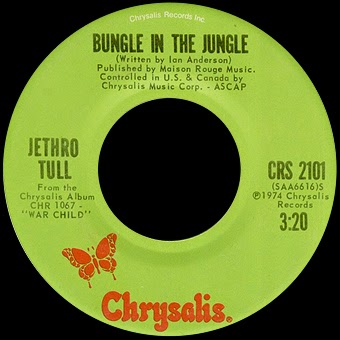Since it’s the fourth week of the month, I typically feature a record label and this month it’s Chrysalis Records. Founded in the UK in 1969, the label’s name was twofold. Chrysalis referenced the pupal stage of a butterfly as well as an amalgamation of the names of the founders:
Chris Wright and Terry
Ellis.
Before Chrysalis became a full-fledged label, its recordings were distributed in the UK by Island Records. Since Island had no outlet in the US at the time, Chrysalis artists were represented by a number of US labels. For example, Jethro Tull appeared originally on Reprise, Ten Years After’s Chrysalis recordings were issued on Columbia (US), and Procul Harum continued their relationship with A&M that had been established by their former UK label, Regal Zonophone.
Because of Jethro Tull’s relationship with Reprise, an arm of Warner Brothers, Chyrsalis debuted in North America as a Warner’s distributed label in 1972. In 1976, the label shifted to an independent distribution status and they were no longer represented by Warners.
In 1990, EMI purchased 50% control in Chrysalis and by the next year gained full control of the label. Eventually Chrysalis ceased to be an imprint with EMI Records being the successor label for Chrysalis artists. Warner Music Group currently owns the Chrysalis catalog – a full circle arrangement.
In the 1980s, a number of New Romantic artists were signed to the label with some having marginal to good success in the US. One of those acts that had marginal success was the British band Ultravox. Singed to Chrysalis when Midge Ure replaced John Foxx as lead vocalist in 1979, Ure’s line up of Ultravox recorded five albums for Chrysalis.
While Ultravox never achieved the success in the US as they did in their native UK, their sound is indicative of the New Romantic musical style of the 1980s. All five Ultravox’s Chrysalis albums were Top 10 releases in the UK; however, in the US only one LP, “Quartet,” charted in double digits when it peaked at #61 in 1982.
While their singles did exceedingly well in the UK with 16 charting in the Top 40 and one of those, 1980s “Vienna,” charting twice (at #2 and as a 1993 reissue at #13). Only two Ultravox singles charted in the US. “Dancing with Tears in my Eyes,” their second highest charting UK single at #3, only made it to #108 in America.
Today’s feature, 1983’s “Reap the Wild Wind,” peaked at #71 in the US despite its success at #12 in Britain. Unfortunately, it was greatest level of success that Ultravox garnered on this side of the Atlantic. “Reap the Wild Wind” was the debut single from their best selling US LP “Quartet.” Good stuff from a little known band in the US.































